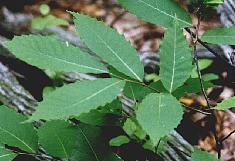Castanea dentata Cupuliferae
For millennia, mankind has domesticated this plant genus for its numerous uses, from feeding to tanning. It originated in Asia Minor: Persia, Armenia, Transcaucasia? In any case, Romans transplanted it to Western Europe. The first chestnut groves date back to when arboriculture techniques, such as pruning, budding or grafting had been mastered. During the Middle Ages, monasteries saw to preservation and development of chestnut groves. These trees are found at 1,500-2,500 ft elevations, on acidic soils (schists, granite; chestnuts hate limestone), and below about 52° N latitude, since frost destroys the flowers. It is not known when chestnut trees were introduced in North America.
 Prior to European colonization, vast stands ranged from Maine to Florida, with the largest trees occurring in the Southern Appalachians. In the pre-settlement forests, chestnut trees often occupied as much as 60% of the canopy. Native Americans used it for the sweet-tasting small (ca. 5 g) brown nuts. The American species was the largest growing (ca. 30 m-tall) and straightest trunked of all the chestnut trees. The female flowers appeared late, not before June-July, with splendid displays of creamy yellow blossoms, strongly scented, and they coexisted with long male catkins. The prickly burr of the sweet chestnut is green, it appears in September after pollination by wind or insects. A grown tree produces about 50 kg of chestnuts per year.
Prior to European colonization, vast stands ranged from Maine to Florida, with the largest trees occurring in the Southern Appalachians. In the pre-settlement forests, chestnut trees often occupied as much as 60% of the canopy. Native Americans used it for the sweet-tasting small (ca. 5 g) brown nuts. The American species was the largest growing (ca. 30 m-tall) and straightest trunked of all the chestnut trees. The female flowers appeared late, not before June-July, with splendid displays of creamy yellow blossoms, strongly scented, and they coexisted with long male catkins. The prickly burr of the sweet chestnut is green, it appears in September after pollination by wind or insects. A grown tree produces about 50 kg of chestnuts per year.
Chestnut trees are exceptionally long lived. Trees in Europe are reported to reach over 1,000 years old. The natural life expectancy is in the range of 200-800 years. The nut output peaks at 35-50 years. The livelihood of entire populations of both Native Americans and colonists was tied to chestnut groves. For settlers in the southern Appalachians, it was a major economic resource. The chestnuts provided a food rich in complex sugars, low in protein (~ 5%) – albeit of high quality, comparable to eggs-and very low in fat, providing also vitamin C and potassium. The reddish-brown wood, very resistant to decay and weathering, soft and light, easy to work, had numerous uses: from cabinet-making to railroad ties and telephone poles, log cabins and also caskets.
The tannic acid from the bark and wood served in the tanning of leather. When the substance binds to collagen, the fibers become crosslinked and are thus made more resistant to attack. This application became of such importance that lumber operations became subsidiaries of leather companies. In cities, big and small, chestnuts were a familiar and much beloved sight: “Under a spreading chestnut-tree/The village smithy stands (…) From my arm-chair/ to the children of Cambridge Who presented to me on my Seventy-second Birth-day, February 27 1879, this Chair, made from the Wood of the Village Blacksmith’s Chestnut Tree/ perhaps, by right divine of song/ It may to me belong; /Only because the spreading chestnut tree/ Of old was sung by me.
Henry Wadsworth Longfellow. Around 1904, appeared a blight imported from Japan or China, Endothia parisitica. It was first found by a forester at the Bronx Zoo, Herman W. Merkel. Within forty years, it had wiped out most of the American chestnut trees in the eastern US. The American chestnut has become a near-extinct species. Attempts are under way to reintroduce it, with help from techniques of genetic engineering.

